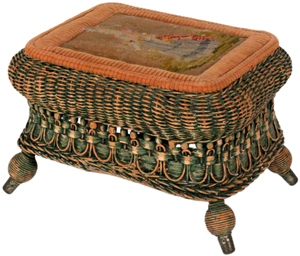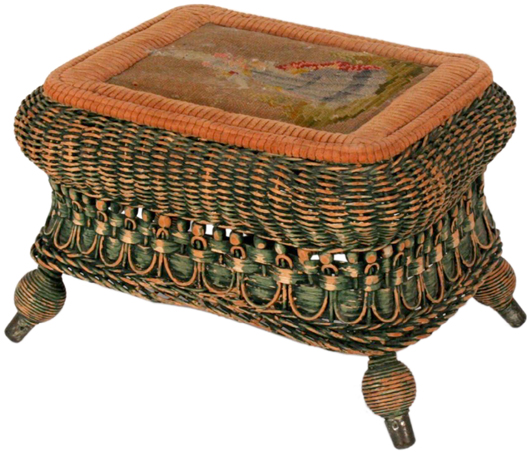
A cricket is an insect, but it also may also be a footstool. The cricket (footstool) was usually no more than l2 inches high. It was used as a seat for young children in school or as a footrest. Larger stools, 12 to 18 inches high, were used for seating teenage children and adults. A few stools were used like steps to help short people get into bed, and some very tall stools were made for standup desks. Taverns often used stools as seats. Chairs were made only for kings and very important people until the early 1700s.
Chair-makers made stools in popular chair styles. Upholstered stools were billed as chairs were: one charge for the frame, an added one for the upholstery. Fabrics were expensive before the end of the 1800s, so the frame usually cost less than the fabric.
Footstools are still popular as pull-up seating, low tables and footrests, and for small children. They have been made in all styles and all sizes.
Q: I have an old 9-inch figurine with “Chas Chaplin” engraved into the front of the base. The mark printed on the bottom is “Mark Hampton Co. Inc., 1328 Broadway, New York City, Copyrighted 1915-1910.” What is it worth?
A: Charlie Chaplin was the most famous film star in the world by the end of World War I. His legacy and star power carry on to the present day. Early 20th-century figurines like yours are collectible. A Mark Hampton Co. Charlie Chaplin figurine in good condition with the original box recently sold at auction for $275.
Q: My coffeepot is marked “D.W. Haber & Son, pat. 3994044, N.Y.” I have been unable to find out anything about it. It’s heavy and polishes up like silver. I bought it for $1 at a yard sale.
A: D.W. Haber & Son was founded in 1902 in New York and is still in business. It began as a silver repair business and then began making heavy silver-plated hollowware for hotels, cruise lines and other commercial uses. Since 2001, manufacturing has been done outside the United States. The company holds several patents, which include improvements to chafing dishes, coffeepots, compotes and urns. The patent on your coffeepot is for a heavy-duty hinge for restaurant and commercial ware. It was filed on Dec. 15, 1975, and issued on Nov. 30, 1976.
Q: I have a 27-inch-tall bronze sculpture stamped with the name Bouret. It is of a young woman adjusting the skirt layers of her dress. My wife and I inherited the figure years ago. Do you know the history of this sculpture?
A: Eutrope Bouret (1833-1906) was a French sculptor. He made many bronze figures, including sculptures of Joan of Arc, classical maidens and Roman gods. Most of his work dates from the late 19th century. His sculptures are collectible, and one of his statues recently sold for $3,256 at auction. But price depends on size, subject and condition.
Q: I have some Jaru ceramic accessories from the 1970s: three vases, a covered ginger jar and a stylized nude figurine. They are all covered with a brown glossy glaze. What value would you attach to these pieces?
A: Jaru Art Products was started in 1950 by Jack and Ruth Hirsh in Culver City, Calif. The name is a combination of the first two letters of their first names (“Ja” and “ru”). Jaru sold artwares and figurines by different artists. The company later created its own lines. Most pieces were marked with a simple paper sticker, although some have an impressed mark. Jaru changed hands in 1968 and stayed in business until the 1990s by diversifying and importing products. Collectors prefer pieces made before 1980. Your vases and ginger jar could sell for $20 to $75 each; the figurine is worth about $100.
Q: I have a Salvador Dali etching of El Cid. There is a certificate of authenticity glued to the back that states it is an original etching. The certificate is from the Collectors Guild of New York City. I’m curious about the value.
A: Salvador Dali was a famous 20th-century Spanish surrealist painter. Besides painting, he also experimented with sculpture, film and photography. In the early 1960s, he was commissioned to make a print series titled “Five Spanish Immortals” and based on historic Spaniards. The five included El Cid. The original etchings were printed in a total edition of 180 on two types of paper, one in black ink and one in sepia ink. Each example of this edition was hand-signed by Dali in pencil on the lower right corner. Many were marketed by the Collectors Guild. In 1968 the Collectors Guild published a new edition of the “Immortals.” For this edition, Dali etched his name into the printing plate instead of hand-signing the prints. Thousands were printed. A rare hand-signed edition sold at auction in 2012 for $250. An etched-signature edition recently sold for $40.
Tip: Fishing line is strong and almost invisible and can be used to tie fragile items to a base or wall. This will help prevent damage from earthquakes, toddlers and dogs with wagging tails.
Take advantage of a free listing for your group to announce events or to find antique shows and other events. Go to Kovels.com/calendar to find and plan your antiquing trips.
Terry Kovel answers as many questions as possible through the column. By sending a letter with a question, you give full permission for use in the column or any other Kovel forum. Names, addresses or email addresses will not be published. We cannot guarantee the return of any photograph, but if a stamped envelope is included, we will try. The volume of mail makes personal answers or appraisals impossible. Write to Kovels, Auction Central News, King Features Syndicate, 300 W. 57th St., New York, NY 10019.
CURRENT PRICES
Current prices are recorded from antiques shows, flea markets, sales and auctions throughout the United States. Prices vary in different locations because of local economic conditions.
- Harlequin dinner plate, yellow, Homer Laughlin, 1936-1964, 10 inches, $50.
- Figural pig tape measure, silvered brass, wire-tail crank retracts tape, impressed “Pan-American 1901,” souvenir of Buffalo, N.Y., World’s Fair, 2 3/8 inches, $160.
- Gorham sterling-silver salad spoon, Chantilly pattern, light gold wash on bowl, marked, circa 1895, 8 3/4 inches, $165.
- Old Gold cigarettes store display, cardboard, truck with billboard sides, image of woman, two wolfhounds and Old Gold packs, “Not a Cough in a Car Load,” 1930s, 4 x 11 x 5 3/4 inches, $175.
- Cambridge Glass candlestick, Crown Tuscan line, nude woman lifting candleholder above her head, 9 1/2 in., pair, $275.
- Howdy Dowdy’s Clarabell music box, die-cut clown’s head, laminated cardboard, Howdy Doody characters revolve in mouth, F.B.A. Industries, New York, 1950s, 7 1/2 x 8 3/4 inches, $385.
- Hooked rug, floral and log cabin pattern, wool fabric and yarn, various flowers on lavender-gray ground, brown and black border, New Hampshire, circa 1900, 45 x 24 inches, $525.
- Arts & Crafts smoking stand, hand-hammered steel with bronzed finish, dome top, movable handle, storage compartments, ring handles, circa 1910, 38 x 20 x 8 1/2 inches, $875.
- Stump Speaker mechanical bank, cast iron, black man standing next to carpetbag, coin in man’s hand drops into bag, Shepard Hardware Co., 1886 patent, 4 x 9 7/8 inches, $1,020.
- Armand Marseilles character doll, No. 400, bisque head, blue sleep eyes, closed mouth, composition and wood flapper body, folklore costume, black velvet vest, red wool skirt, white pantaloons, 13 inches, $1,750.
Prepublication offer. The best book to own if you want to buy or sell or collect-and if you order now, you’ll receive a copy with the author’s autograph. The new Kovels’ Antiques & Collectibles Price Guide, 2013, 45th edition, is your most accurate source for current prices. This large-size paperback has more than 2,500 color photographs and 40,000 up-to-date prices for more than 775 categories of antiques and collectibles. You’ll also find hundreds of factory histories and marks, a report on the record prices of the year, plus helpful sidebars and tips about buying, selling, collecting and preserving your treasures. Available online at Kovelsonlinestore.com; by phone at 800-303-1996; at your bookstore or send $27.95 plus $4.95 postage to Price Book, Box 22900, Beachwood, OH 44122.
© 2012 by Cowles Syndicate Inc.

ADDITIONAL IMAGE OF NOTE


